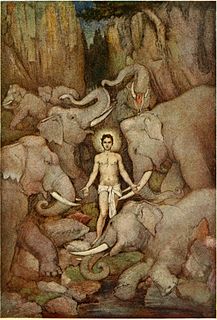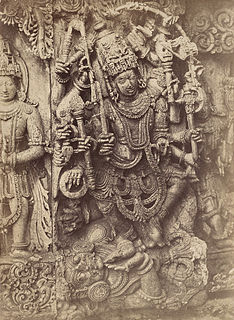 W
WAsuras are a class of beings or power-seeking clans related to the more benevolent Devas in Hinduism.
 W
WAghasura (अघासुर), is a demon (rakshasa) in Hindu and Vedic scriptures.
 W
WAn asura in Buddhism is a demigod or titan of the Kāmadhātu. They are described as having three heads with three faces each and either four or six arms.
 W
WBana is described as an ancient king of Sonitpura in several Hindu Puranic scriptures. Bana was a thousand-armed Asura king, and the son of Mahabali.
 W
WIn Hindu mythology, Bhasmasura, also known as Brahmasura, was an asura or demon who was granted the power to burn up and immediately turn into ashes (bhasma) anyone whose head he touched with his hand. The asura was tricked by the Lord Vishnu's only female avatar, the enchantress Mohini, to turn himself into ashes.
 W
WChitralekha (चित्रलेखा) was a friend of Usha and daughter of minister of Banasura who ruled the present-day central Assam with his capital at Sonitpur.
 W
WDarika is a character in Mudiyettu, a ritualistic dance from the Bhagavathi or Bhadrakali cult, usually performed only in the Kali temples of Kerala. The story is also known as "Darika vadham", or "murder of Darika".
 W
WIn Hinduism, Diti is the Mother of Demons and supporter of Demonic attributes. She is mother of both the Marutas and the Asuras (Daityas) with the sage Kashyapa.
 W
WA Dvarapala or Dvarapalaka is a door or gate guardian often portrayed as a warrior or fearsome giant, usually armed with a weapon - the most common being the gada (mace). The dvarapala statue is a widespread architectural element throughout Hindu, Buddhist and Jaina cultures, as well as in areas influenced by them like Java.
 W
WGhatotkacha is an important character in the Mahabharata. His name comes from the fact that his head was hairless (utkacha) and shaped like a ghatam. Ghatotkacha was the son of the Pandava Bhima and the demoness Hidimbi.
 W
WKāla is a word used in Sanskrit to mean "time". It is also the name of a deity, in which sense it is not always distinguishable from kāla, meaning "black". It is often used as one of the various names or forms of Yama.
 W
WKālayavana was a king who invaded Mathurā with an army of three million yavanas against Sri Krishna.
 W
WKetu is the descending lunar node in Vedic, or Hindu astrology. According to accounts in Hinduism, Ketu belongs to Jaimini Gotra, whereas Rahu is from Paiteenasa gotra; hence the two are entirely different entities with distinct characteristics but nonetheless are two parts of a common body. Ketu is generally referred to as a "shadow" planet. It is believed to have a tremendous impact on human lives and also the whole creation. In some special circumstances it helps someone achieve the zenith of fame. Ketu is often depicted with a gem or star on his head signifying a mystery light.
 W
WKumbhakarna is a named rakshasa and younger brother of Ravana in the famous Hindu Legends in the events of Ramayana. Despite his gigantic size and great appetite, he was described to be of good character and great warrior in those times, though he killed and ate many monkeys only to show his power.
 W
WMahabali, also known as Bali, Indrasenan or Māveli, is a Daitya king found in Hindu texts. Mahabali is the grandson of Prahlada, a descendant of Rishi Kashyapa. There are many versions of his legend in ancient texts such as the Shatapatha Brahmana, Ramayana, Mahabharata, and Puranas. His legend is a part of the annual Onam festival in the state of Kerala, and Balipratipada festival in the North India, Tulunadu and Karnataka. In Kerala tradition, Mahabali, the grandson of Prahlada who was a great devotee of Vishnu, is considered to be the noblest and prosperous king who transforms his kingdom into a land of heaven on earth, and who was given the greatest boon by Vishnu through his Vamana Avatar. Vishnu also gave him the boon that he will become Lord Indra in the next Mahayuga. He asked permission to visit the people of his kingdom on the harvest ceremony to see them live in happiness.
 W
WMamuni Mayan is a culture hero character from Tamil Sangam literature, identified with the asura Maya Dānava (Mayasura) of the Mahabharata, the mythical founder of Vastu Shastra. Romakapura (Sanskrit) [from romaka hairy + pura city, fortified town] City of hairy ones; in the Surya-Siddhanta, is given as the birthplace of Asura maya.
 W
WNarantaka and Devanataka are demons and sons of Ravana who appear in a number of Hindu legends. They, along with Atikaya, were created by Ravana from mandodari, the son of devantaka. Mahakantaka was the only survivor of Raksha clan and was pardoned by Lord Rama and his army. He went far into the Kanyakubj desh and started following Brahmanism.
 W
WPrahlada was a king, the son of Hiranyakashipu and Kayadhu, and the father of Virochana. He belonged to the Kashyapa gotra. He is described as a saintly boy from the Puranas known for his piety and bhakti to Vishnu. Despite the abusive nature of his father, Hiranyakashipu, he continued his devotion towards God Vishnu. He is considered to be a mahājana, or great devotee, by followers of Vaishnava traditions and is of special importance to devotees of Narasimha avatar. A treatise is accredited to him in the Bhagavata Purana in which Prahlāda describes the process of loving worship to Vishnu. The majority of stories in the Puranas are based on the activities of Prahlāda as a young boy, and he is usually depicted as such in paintings and illustrations.
 W
WRāhu () is one of the nine major astronomical bodies (navagraha) in Hindu texts. Unlike most of the others, Rahu is a shadow entity, one that causes eclipses and is the king of meteors. Rahu represents the ascension of the moon in its precessional orbit around the earth.
 W
WIn Hinduism, Raktabīja was an asura who fought with Shumbha and Nishumbha against Goddess Parvati and Goddess Kali or Goddess Chamunda. Raktabīja had a boon that whenever a drop of his blood fell on the ground, a duplicate Raktabīja would be born at that spot. According to some sources, Raktabija was, in his previous birth, Rambhasura, king of demons and the father of Mahishasura.
 W
WSooranporu or Soorasamharam part of Skanda Sashti Vratham festival is a ritual folk performance that recreates the killing of Asuras by Lord Murugan. It is performed in Tamil Nadu, Sri Lanka and the district of Palakkad in Kerala at temples dedicated to Murugan. The Soorasamharam festival is also celebrated in Thiruvannur Subramanya Swami temple in Kozhikode District kerala for more than a century in the name Sooranpada. The 2020 date is 20 November.
 W
WSvarbhānu or Swarbhanu is a Hindu Asura traditionally held responsible for solar eclipses in Vedic mythology. The name is also used as an attribute of the demon Rahu and Ketu in Puranic mythology, who are also connected to Solar Eclipse and Lunar Eclipse.
 W
WTripurasura is a trio of asura brothers named Tarakaksha, Vidyunmāli and Kamalaksha, who were the sons of the asura Tarakasura. These three began to perform tapasya. For a hundred years they meditated standing only on one leg. For a thousand more years they lived on air and meditated. They stood on their heads and meditated in this posture for yet another thousand years.
 W
WTrishira was a Rakshasa, and reference to him is found in the Ramayana. He was one of the six sons of Ravana, and his other brothers were Meghanada, Atikaya, Akshayakumara, Narantaka and Devantaka.
 W
WVaruna is a Vedic deity associated initially with the sky, later also with the seas as well as Ṛta (justice) and Satya (truth). He is found in the oldest layer of Vedic literature of Hinduism, such as hymn 7.86 of the Rigveda. He is also mentioned in the Tamil grammar work Tolkāppiyam, as the god of sea and rain. He is said to be the son of Kashyapa.
 W
WVritra is a Vedic serpent, dragon or demon in Hinduism, the personification of drought and adversary of Indra. Vritra is identified as an Asura. Vritra was also known in the Vedas as Ahi. He appears as a dragon blocking the course of the rivers and is heroically slain by Indra.